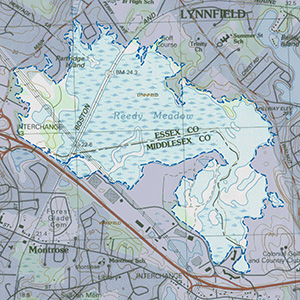Important Bird Area Sites in Massachusetts
Important Bird Area: Lynnfield Marsh
Site Summary
Nominated By
Chris Leahy
Size
1,200 acres
Towns and Counties
Lakefield, Winfield; Essex, Middlesex
Ownership
Towns of Wakefield and Lynnfield
Major Habitats
emergent freshwater marsh 90%; urban/suburban 4%; (oak-conifer forest, palustrine woodland swamp, shrub-scrub wetland, lake/pond, river/stream, migratory stopover site) 6%
Land Use
nature & wildlife, conservation/land trust, hunting & fishing, other recreation, water supply, utility/ right-of-way, suburban/ residential, urban/ industrial/ commercial
Serious Threats
nonnative invasive plants
IBA Criteria
- Category 1: Sites important for long-term research and/or monitoring projects that contribute substantially to ornithology, bird conservation, and/or education.
- Category 4: Sites containing assemblages of species characteristic of a representative, rare, threatened, or unique habitat within the state or region.
- Category 5: Sites regularly holding significant numbers of an endangered, threatened, vulnerable, or declining species.
Site Description
This IBA, also known as Reedy Meadow, is an area of extensive freshwater marsh in the floodplain of the Saugus River. The system was dammed to store water for the city of Lynn. The site is surrounded by urban and suburban development. Possibly, it is the largest contiguous emergent freshwater marsh in Massachusetts. The habitat is predominantly cattail marsh with some significant invasions of Common Reed and Purple Loosestrife, but there are also areas of scrub, especially Buttonbush, swamp; an area of seasonally flooded canary-grass meadow; some areas of Tussock-sedge meadow; bordering areas of wooded Red Maple swamp; and some wooded islands and peninsulas dominated by oak-conifer forest. There are also several ponds. The marsh is surrounded by dense suburban development with a golf course forming a boundary to the west, an industrial park, and a business park on a largely artificial island near the south end.
Current Conservation Status
This IBA forms part of the city of Lynn drinking water supply. Lynnfield Marsh is listed in a National Registration of Significant Landscapes. The Saugus River Watershed Council is an active supporter. The town of Wakefield put some resources into trail development and signs for passive recreation, and the town of Lynnfield established a nature trail with a viewing platform, but these efforts appear to have been abandoned. Development and a variety of disturbances have clearly taken their toll on the wildlife of Lynnfield Marsh, though it is unclear which of the many elements are principally to blame for the apparent decline in the marsh bird community for which the site was once justly famous.
Ornithological Significance
This site historically contained some of the largest breeding populations of marsh birds in Massachusetts, including five state-listed species. Though the habitat is degraded and the populations of listed species have declined or disappeared, the site remains a potentially viable habitat of great importance. The reasons for the decline of bird populations are unclear, though the various forms of pressure from the heavy surrounding development are doubtless responsible. Though the Lynnfield Marsh avifauna has declined so disastrously, the ecological damage that has occurred is not irreversible. Given the marsh's former significance as a breeding area for some of the Commonwealth's rarest bird species, these may still occur in small numbers or might be restored. Furthermore, IBA status could be powerful in encouraging conservation efforts, which are already being undertaken by the local watershed association and others. The marsh would be an excellent site for a case study documenting its natural and cultural history, its development and ecological decline, and its restoration.
Other Flora or Fauna of Significance
Glaucous Sedge is a state endangered species. Uncommon species include Shrubby Cinquefoil and Harris' Checkerspot butterflies.
Data Sources
The Massachusetts Natural Heritage and Endangered Species Program undertook a statewide survey of marshbirds in the mid-1980s. Other records can be gleaned fromRecords of New England Birds (historical) and Bird Observer (recent).




